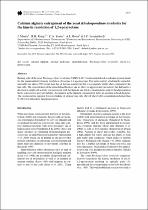JavaScript is disabled for your browser. Some features of this site may not work without it.
- ResearchSpace
- →
- Research Publications/Outputs
- →
- Journal Articles
- →
- View Item
Advances in enzyme immobilisation
http://www.springerlink.com/content/g71665208l264352/fulltext.html
http://www.springerlink.com/content/g71665208l264352/
http://hdl.handle.net/10204/4008
http://www.springerlink.com/content/g71665208l264352/
http://hdl.handle.net/10204/4008
Improvements in current carrier-based immobilisation strategies have been developed using hetero-functionalised supports that enhance the binding efficacy and stability through multipoint attachment. New commercial resins (Sepabeads) exhibit improved protein binding capacity. Novel methods of enzyme self immobilisation have been developed (CLEC, CLEA, Spherezyme), as well as carrier materials (Dendrispheres), encapsulation (PEI Microspheres), and entrapment. Apart from retention, recovery and stabilisation, other advantages to enzyme immobilisation have emerged, such as enhanced enzyme activity, modification of substrate selectivity and enantioselectivity, and multi-enzyme reactions. These advances promise to enhance the roles of immobilisation enzymes in industry, while opening the door for novel applications.
Reference:
Brady, D and Jordaan, J 2009. Advances in enzyme immobilisation. Biotechnology Letters, Vol. 31(11), pp 1639-1650
Brady, D., & Jordaan, J. (2009). Advances in enzyme immobilisation. http://hdl.handle.net/10204/4008
Brady, D, and J Jordaan "Advances in enzyme immobilisation." (2009) http://hdl.handle.net/10204/4008
Brady D, Jordaan J. Advances in enzyme immobilisation. 2009; http://hdl.handle.net/10204/4008.
Copyright: 2009 Springer Netherlands. This is the author’s post print version. It is posted here by permission of Springer Netherlands for your personal use. Not for redistribution. The definitive version has been published in the Journal of Biotechnology Letters, Vol. 31(11), pp 1639-1650
10 Jul 2009
Enzyme
Biocatalysis
Biocatalyst
Immobilisation enzyme
Sepabeads
Immobilisation
Hetero-functionalised supports
Encapsulation
Entrapment
Support based immobilisation
Self immobilisation
Biocatalysis
Biocatalyst
Immobilisation enzyme
Sepabeads
Immobilisation
Hetero-functionalised supports
Encapsulation
Entrapment
Support based immobilisation
Self immobilisation
Files in this item
Related Items
This item appears in the following Collection(s)
Related items
Showing items related by title, author, creator and subject.
-
Author: Maritz, J ; Krieg, HM ; Yeates, CA ; Botes, AL ; Breytenbach, JC Date: Oct 2003 Resting cells of the yeast Rhodosporidium toruloides (UOFS Y-0471) were immobilized in calcium alginate beads for the enantio selective kinetic resolution of racemic-1,2-epoxyoctane. The initial activity exhibited by immobilised cells was ... Read more
-
Author: Twala, BV ; Sewell, BT ; Jordaan, J Date: Jan 2010 Immobilisation of enzymes is of considerable interest due to the advantages over soluble enzymes, including improved stability and recovery. Glucose Dehydrogenase (GDH) is an important biocatalytic enzyme due to is ability to recycle the ... Read more
-
Author: Visser, Daniel F ; Hennessy F ; Rashamuse J ; Pletschke B ; Brady D Date: Aug 2010 Uridine phosphorylase from Escherichia coli was evolved by iterative saturation mutagenesis. The best mutant showed a temperature optimum of 60C and a half-life of 17.3 h at 60C. The mutant enzyme, as well as a purine nucleoside phosphorylase ... Read more
Browse
-
All of ResearchSpace
-
This Collection
Legislation and compliance
General Enquiries
Tel: + 27 12 841 2911
Email: callcentre@csir.co.za
Physical Address
Meiring Naudé Road
Brummeria
Pretoria
South Africa
Postal Address
PO Box 395
Pretoria 0001
South Africa
Copyright © CSIR 2017. All Rights Reserved
Resources on this site are free to download and reuse according to associated licensing provision. Please read the terms and conditions of usage of each resource.








